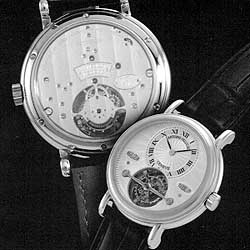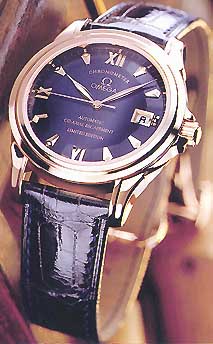PERHAPS LESS KNOWN |
![]()
|
|
|
| Eric
Loth and Pierre-André Finazzi, both active in the
technical and administrative domains of watchmaking in La
Chaux-de-Fonds, Switzerland, dreamed of having their own
brand, but what they found interesting in Switzerland
proved too expensive and what they could afford in France
was not interesting enough. So, in 1994, Loth and Finazzi
bought six of the most respected English brands, that is,
Tompion, Graham, Arnold & Son, Mudge, Earnshaw and
Quare. Although reluctant to name the price paid for
these acquisitions, the two men did admit, "It cost
us a bundle." Having acquired this handful of
horological history, Loth and Finazzi then found a
partner, Ernst Thomke, to help them develop it. It seems
that the man who "fathered" the plastic Swatch
nearly two decades ago is again moving into the world of
watches. Besides his interest in Les Monts SA, Ernst
Thomke was recently named as advisor to the Sandoz
Foundation in its watchmaking (Parmigiani Fleurier) and
telecommunications sectors. Of the six British brands now
owned by Les Monts, three were chosen for immediate
resuscitation. These brands represent three names which
have made inestimable contributions to English
watchmaking: Thomas Tompion, George Graham and the
dynasty of Arnold & Son. The first Tompion is an
alarm watch with two time zones (GMT). The new Arnold
& Son is a classic timekeeper conceived in the style
of a marine chronometer with a power reserve of seven
days. Last but not least, the new Graham is a split-second
chrono-graph with a lightning-fast second hand. Text quoted from Michel Jeannot's English horology. Click on name to read in full. |
| Born in Geneva in 1957, Antoine Preziuso is one of the rising stars in fine Swiss watch making today. Minute repeaters, ornamented with engraved and animated decors, tourbillons, chronographs, and skeletonized watches are all part of Antoine Preziuso's tribute to the great craftsmen of the past. He is not only content to improve on traditional mechanisms, but genuinely innovates, especially in the complex repeater domain. |  |
| On the left is one of Antoine's supreme creations, a minute repeater chronograph. Movement: mechanical with manual winding and with 40 hours of autonomy, quality certificate "Poincon de Genève," micrometer setting system, 32 rubies. The functions are: hours and minutes, repetition of the hours, quarter hours and minutes, perpetual calendar indicating the phases of the moon, the day, the week, the date, the month of 28, 29, 30 or 31 days until the year 2100, including leap years. Connoisseurs of a different breed might be familiar with one of Antoine Preziuso's other specialties, rather graphic mechanical erotic timepieces, which you may look up by clicking on any of the images here. |
|
And now for something completely different... In the mid-1980s, Dr. Georg Konradsheim began to ponder how to bring together two fascinating technical worlds, which also happened to be his two favorite passions: automobiles and watches. Then, when he asked himself what best symbolizes mobility and speed, he had the perfect solution. |
| The speedometer, of course! With this in mind, he created a special wristwatch. The distinguished speedometer of the Carrera RS 2.7 had the ideal face, so ideal that he produced it in miniature form, down to the last detail. Its needle became the minute hand, complemented by an understated black hour hand. With most Motochron watches, it isn't easy to check the precision of movement - as there are no minute and second dials. 1935. The Messerschmitt ME 109 takes off on her maiden flight. For many years afterward, it was the world's fastest propellor airplane. Today, Motochron is commemorating this remarkable plane by featuring its speed indicator on the Motochron Aero 2 Chronometer ( above left). The F 104 Starfighter is the inspiration for the Motochron Aero 3 model (above right). You will find the plane's gradient indicator replicated in detail on the Aero 4 dial. Even the words "up" and "down", barely seen by the naked eye, have been meticulously printed, black on black. |
| The origin of the famous American plane dates back to 1952. After much development and continuous improvements, the Starfighter was exported heavily from the USA, and was used in several conflict areas around the world. The perfection of Mercedes automobiles and the precision of Swiss watches. Pure harmony. Take the W 124, for example. The speedometer of this elegant "E-Class" limousine makes a watch face of a superior- quality chronometer. There is only one difference - a date calendar is at the 6 o'clock position (right). |
 |
CHASE-DURER watches represent extremely good value. They use ETA movements, among them VALJOUX 7750 the same one used in many more expensive watches. Their Geneva office is gearing up to manufacture as many watches as possible to satisfy a world-wide demand. |
| At the beginning of the 20th century, it consisted of manufacturers of watch parts (cases, dials, hands, bands, crowns, crystals...). Between 1932-34 the production of the first movements started. In the succeeding decades, Pforzheim developed into the center of the German watch and jewelry industry. In 1924, Karl Ickler founded a company for watch parts, mainly watch cases in Pforzheim. During the Second World War, production ceased, but was taken up in 1947 by the founder's sons Heinz and Kurt Ickler. In the following years Karl Ickler KG developed to an important supplier of watch cases and parts of German and international customers. In 1979 with Thomas Ickler the third generation came into the company. In 1990 Ickler GmbH began to produce private label watches. Years later they started planning their own watch brand. |
|
|
|
| Limes models have an attractive techno design that is reminiscent of many of today's pilot-type watches. Representative examples of the Limes line are (from top left): Romulus (VAL 7750), Limes (ETA 2824-2), Auto Titanium (ETA 2824-2), Nightflight (ETA 2824-2), Chyros (VAL 7750), and Outback (VAL 7750). The prices that are quoted on the company's web site range from a very reasonable DM 240 for Nightflight to an equally reasonable ca. DM 1950 for Romulus. |
 |
In the past, the name Philippe Dufour was only known to the most ardent watch enthusiasts, and with his extremely limited output, this is unlikely to change. On the right is one of his world premieres, the Double Escapement wristwatch. This is a complication that, like Omega's new Daniels Co-Axial escapement (left), is supposed to increase the accuracy of a watch more effectively than a tourbillon. Dufour's stunning timepiece is destined to please the connoisseur who not only wishes to wear a beautiful watch but also appreciates the complication of such a duality. |
The technical aspect of the Double
Escapement may be deceptive at first glance. A closer examination reveals
that this system is actually more complex than a
Tourbillon. Created with the future in mind, it is also a
reminder of the past when time was a gift of life to be
treated with affection and care. When time was taken to
appreciate the beauty of a master creation. Philippe
Dufour is established in the Vallée de Joux where he
designs and produces the entirety of his watches. An old
wood-panelled class room in Le Solliat, where children
used to dream and work, serves him as workspace:
permanent reminder that true mastery can only be achieved
when appreciating the knowledge of the past to create the
future. |
| Page 1: hello |
Page 2: nice things |
Page 3: Audemars Piguet |
Page 4: IWC, JLC |
Page 5: Patek Philippe |
| Page 6: Flieger |
Page 7: more Flieger |
Page 8: Zenith, Eberhard |
Page 9: chronographs |
Page 10: big money! |
| Page 11: mo' money |
Page 12:
more chronos |
Page 13: less known gems |
Page 14: moonstruck |
Page 15: pictures & links |